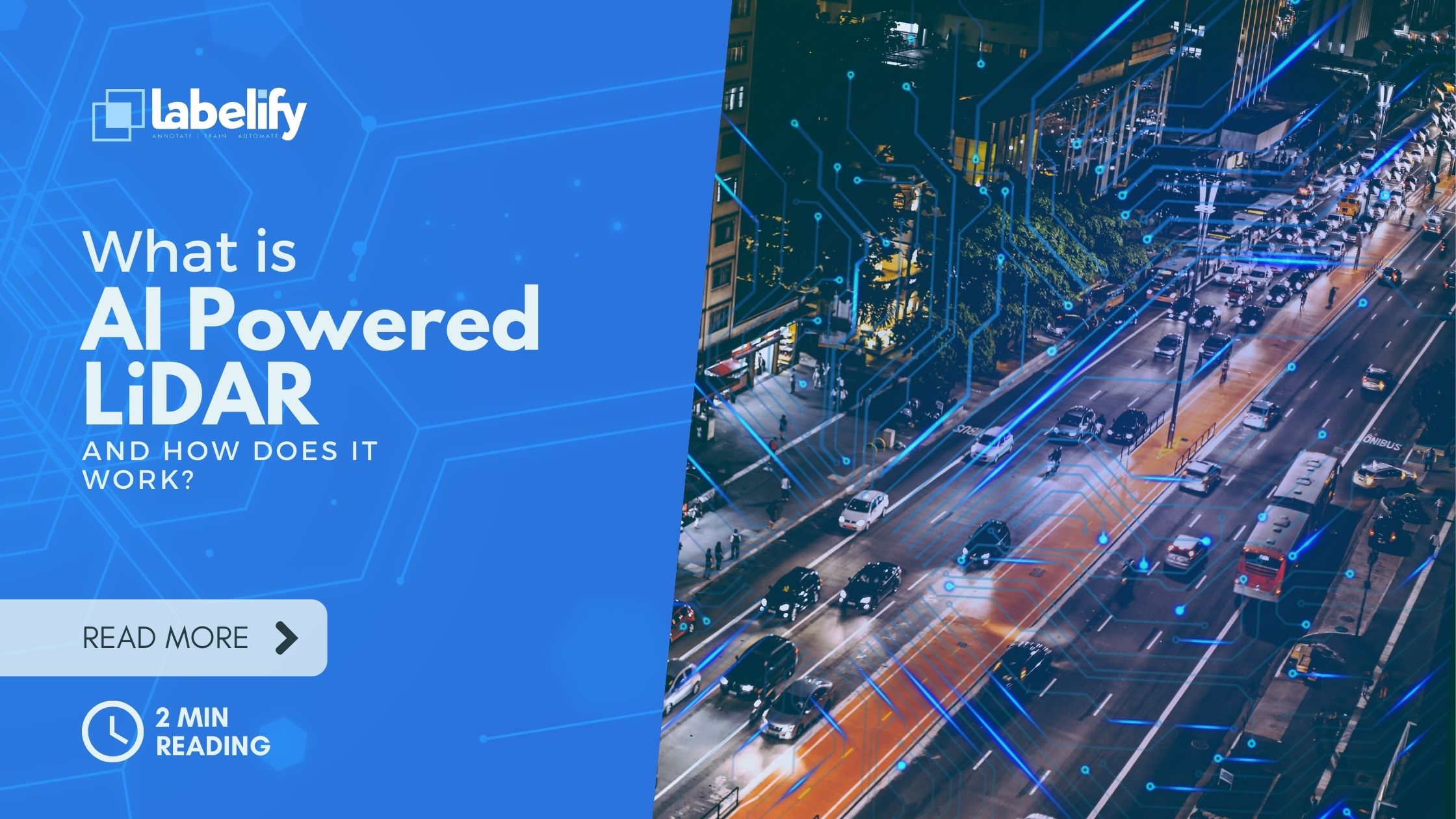What Is AI-powered LiDAR ?
Although LiDAR has been a valuable tool in many industries for decades now, artificial intelligence (AI-powered) is only beginning to unlock its full potential. LiDAR (also known as light detection & ranging) is a remote sensing technique. Laser scanners are used to measure distances between the target object and the sensor, such as a pedestrian or building. Teams are using AI in conjunction with LiDAR to optimize the technology for unprecedented speed and precision across a range of applications.
Since the 1960s when LiDAR was installed on planes for scanning terrain, LiDAR has existed in some form. LiDAR became more popular with the advent of GPS in the 1980s. GPS allowed the data from LiDAR scans for use in building 3D models. As LiDAR costs are declining and the amount of LiDAR data is available, LiDAR’s recent pairing with AI/machine learning (ML), opens up major innovation opportunities.
How LiDAR works
A LiDAR system typically consists of four key components:
- Laser: Uses light pulses to send light waves to targets (buildings, vehicles, pedestrians, etc.). The type of LiDAR used will determine the type of light waves that are sent.
- Scanner: Controls how fast the laser scans target objects, and how far the laser can reach.
- Sensor: This sensor measures the time taken for the light beam to bounce off the object of interest and return to the LiDAR system.
- GPS: This tracks the LiDAR system’s location to make sure that distance measurements between the target object (or system) are accurate.
Modern LiDAR systems can send up to 500,000 pulses per second. These pulses are then compiled into a point cloud. This is a collection of coordinates that represent objects in space. The point cloud can then be used to create a 3-D model of the space.
There are two major types of LiDAR.
- Airborne LiDAR
Airborne LiDAR, as the name implies, requires that the system be mounted on a flying device, such as a drone or plane. The LiDAR sends pulses down to the ground to monitor the relevant conditions. Two types of aerial LiDAR are available:
Bathymetric: Measures the depth of water bodies using green light.
Topographic: This is used to map the land’s surface.
- Terrestrial LiDAR
The LiDAR system can be mounted on a vehicle or on a tripod attached to the ground. It scans in all directions and can be used to create 3D models from point clouds. There are two types:
Mobile: A LiDAR can be installed on a train or boat. It is useful for monitoring roads, pedestrians, signs and conditions as well as other infrastructure.
Static: The LiDAR scans the area around a fixed point in the ground or a particular feature such as an interior of a building.
LiDAR and AI:
LiDAR and AI are a natural match. LiDAR gathers 3D points to build a point cloud. AI thrives processing data. The pulse rate of LiDAR can produce multiple returns from the same laser pulse and ranges from 10,000 to 200,000 pulses per second. AI models can process the output of LiDAR return to make sense of an environment (e.g. topographical maps).
To identify the key objects in the scan, teams used to manually label the LiDAR data. The effort required specialized knowledge and was time-consuming, laborious, and tedious. AI is now able to automate labeling thanks to computer vision and image processing. It can process unstructured input data and output target objects (e.g., vehicles, infrastructure, etc.) for further analysis.
We can now create 3D models that are accurate and up-to-date using the time-savings offered by AI. These advances have led to many applications of AI and LiDAR that are applicable across all industries.
AI-powered LiDAR: Real-world Applications
LiDAR is vital to many industries, including architecture, manufacturing and oceanography. These are just a few examples of AI applications that LiDAR can be used in:
自動運転車
Although self-driving cars are not yet common on roads, they will be in the near future. These vehicles will require AI-powered LiDAR to scan and create 3D models of the area and make decisions about how to proceed. This is in addition to data input from cameras and RADAR. For the safety of the passengers, accurate LiDAR is essential.
農業
Teams use AI-powered LiDAR systems on drones to create topographical maps for agriculture. These maps are used by farmers to determine the best areas for crops and where to apply fertilizer. LiDAR can be used by farmers to track crop yields after seed dispersion.
Safety in Construction and Military
For decades, many militaries have used LiDAR to identify suspicious objects and scout borderlines. We may soon see autonomous surveying of potential danger areas, thanks to AI’s increased opportunities. Workers in hazardous construction jobs or related fields may be protected by autonomous robots.
Due to improvements in computer processing power, and the allocations of more resources to invest into AI opportunities, LiDAR and AI continue to grow in partnership. Because LiDAR is already used in many industries, innovation will soon be a part of every aspect of our lives. This will help us to experience AI-powered technology in a way that we enjoy.
Spatial Computing Applications: From Smart Cars to Smart Phones
The full 3D information of the scanned objects and their surroundings can be accessed by using LiDAR. This opens up a wide range of applications, particularly when spatial information, such as depth, distance, geometry and dimension, is important for your particular use case. It could be inventory management in retail or quality assurance in construction. One great use case that has seen a lot of interest this year is that of car companies that use LiDAR for detecting objects on the roads, improving their ADAS applications (Advanced Driver-Assistance System). Even smartphones can use LiDAR -iPhone 12 Pro comes with LiDAR to help separate background from foreground and take better portrait mode photos. This is only a small part of the many LiDAR applications that can be found in a variety of industries.
3D Deep Learning for spatial computing
Deep Learning (DL) is used by experts from all industries to understand 3D scanned data. It’s almost impossible to comprehend all data points without AI. AI also gives you the ability to analyze 2D images at scale. DL algorithms are able to compare DL solutions in one dimension (e.g. speech recognition) and in 2D (for image signals). They can also maintain real-time performance and low memory footprint, with additional dimensions being added. Experts are trying to make the most of irregular data and maintain precision. This is not an easy task. How can they create an AI that is capable of generating reliable reasoning from imperfect scans? And how do they power these new applications? These are all fascinating topics that we should continue to research and may help to improve the useability of LiDAR DL models.
Get more information about our platform, or contact us to speak directly with someone.




